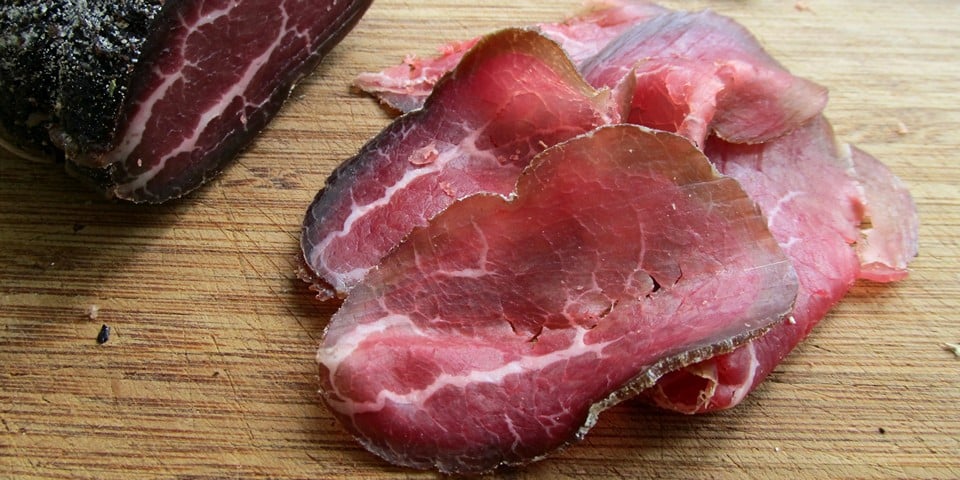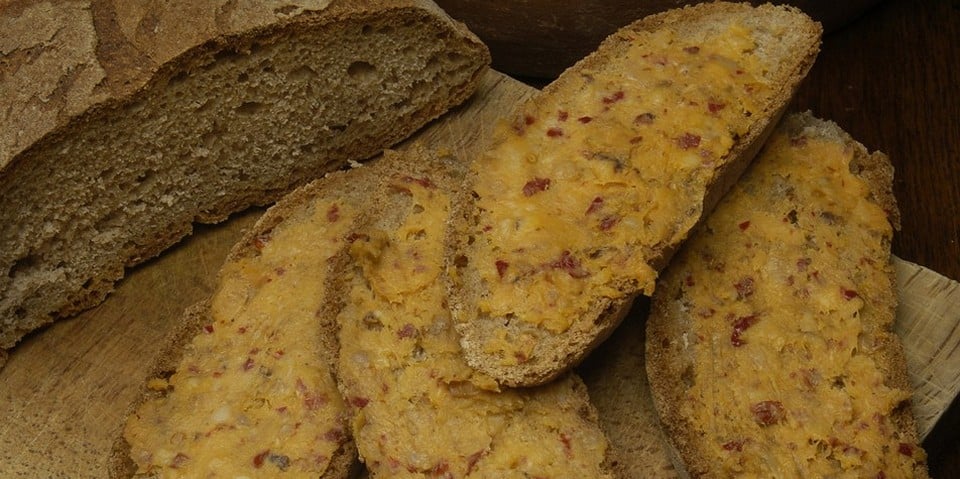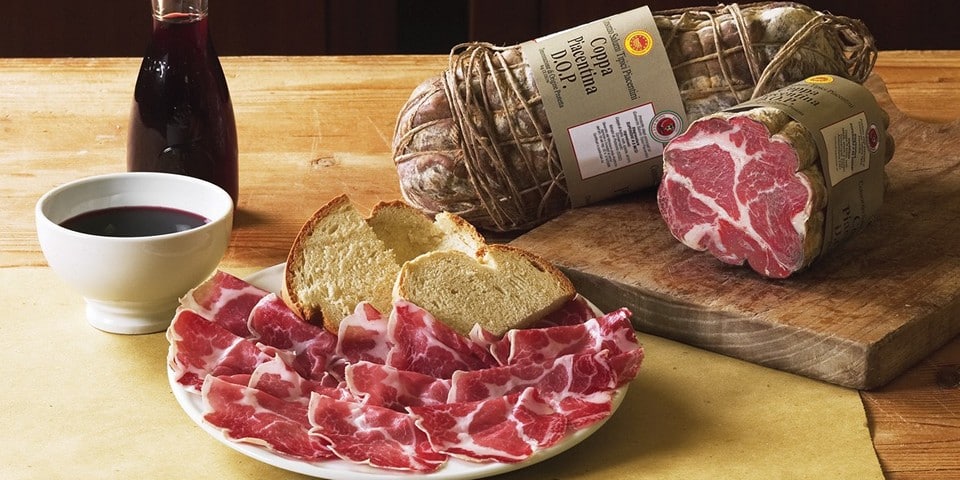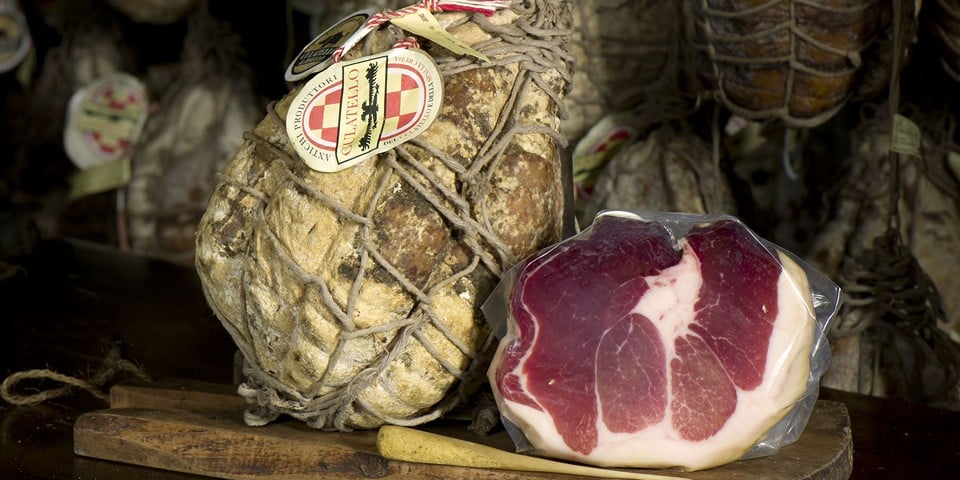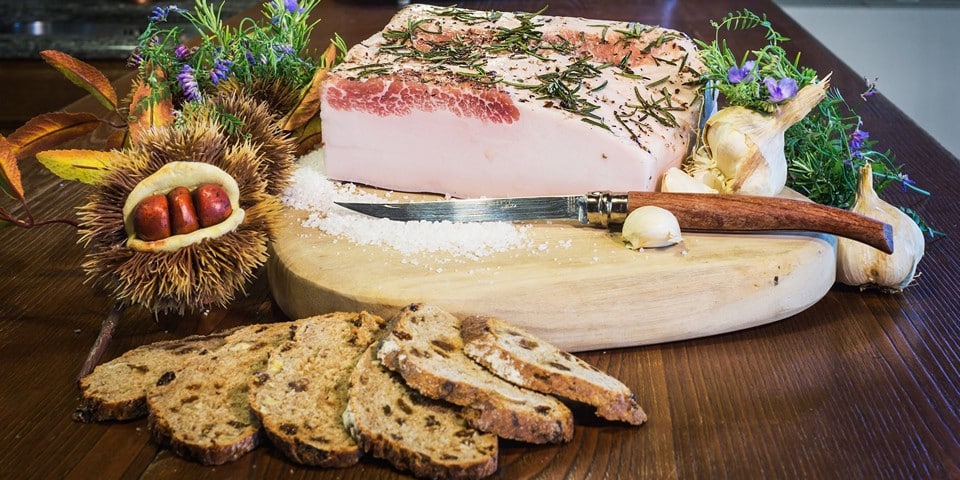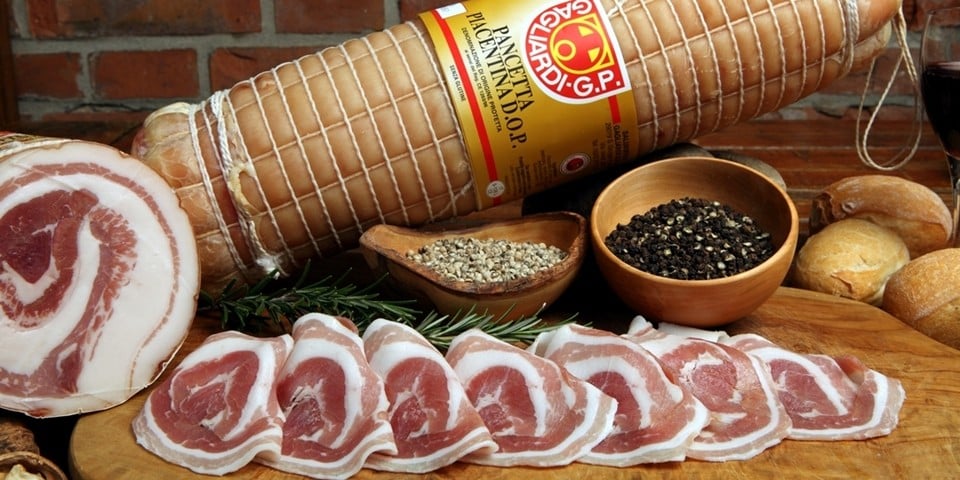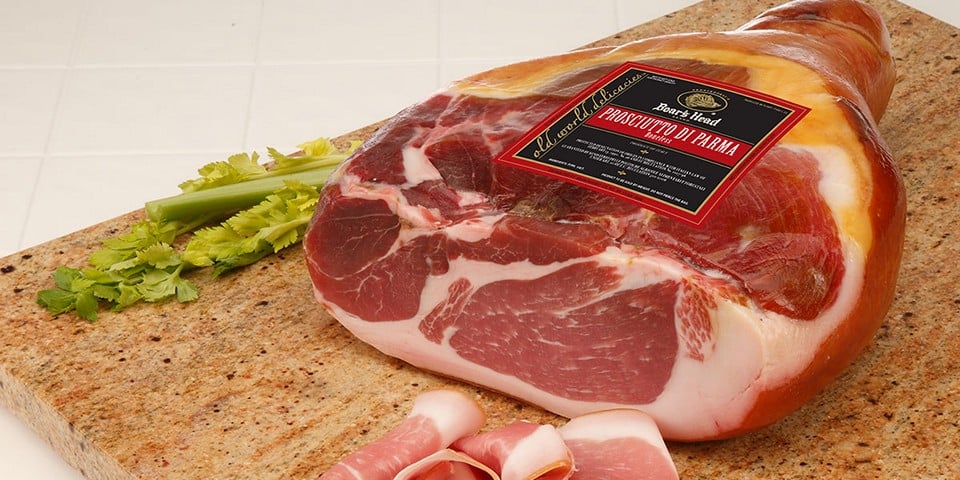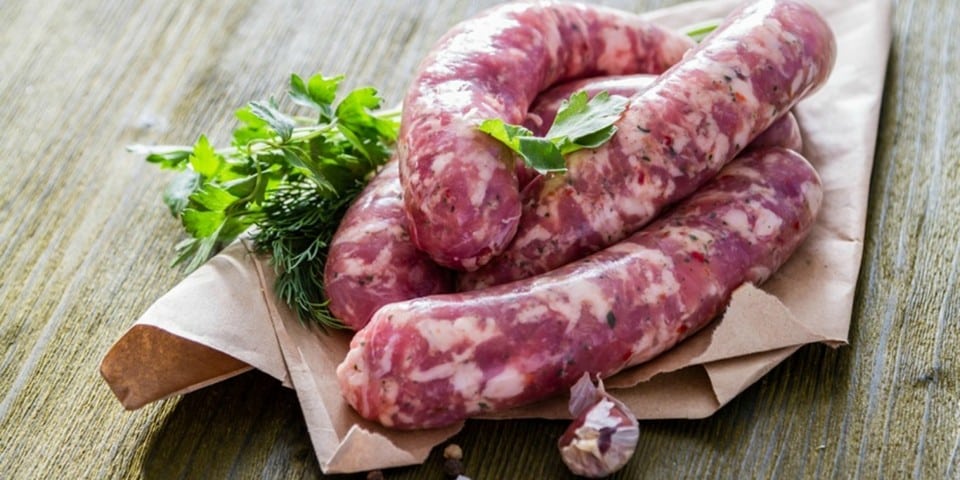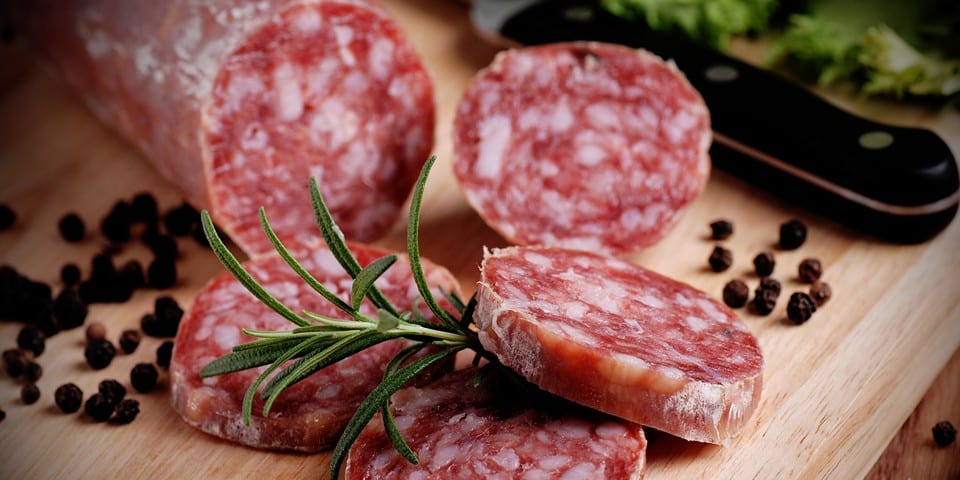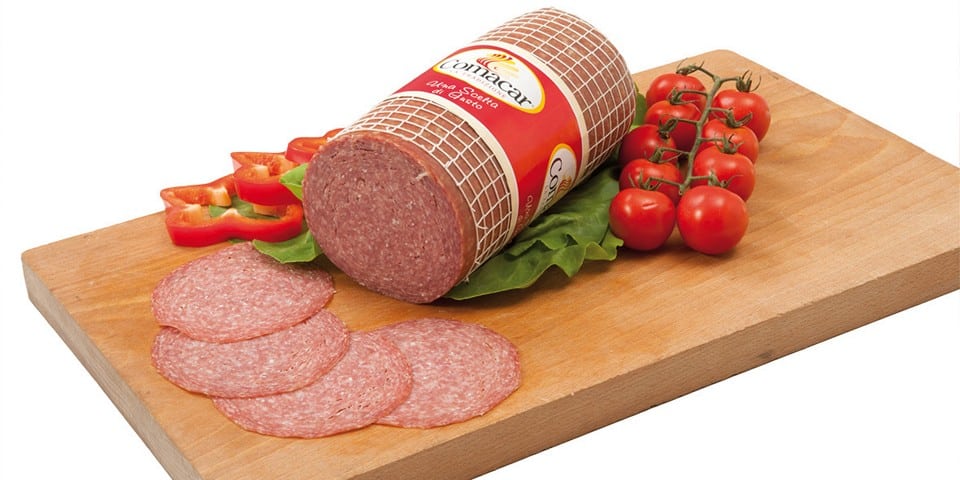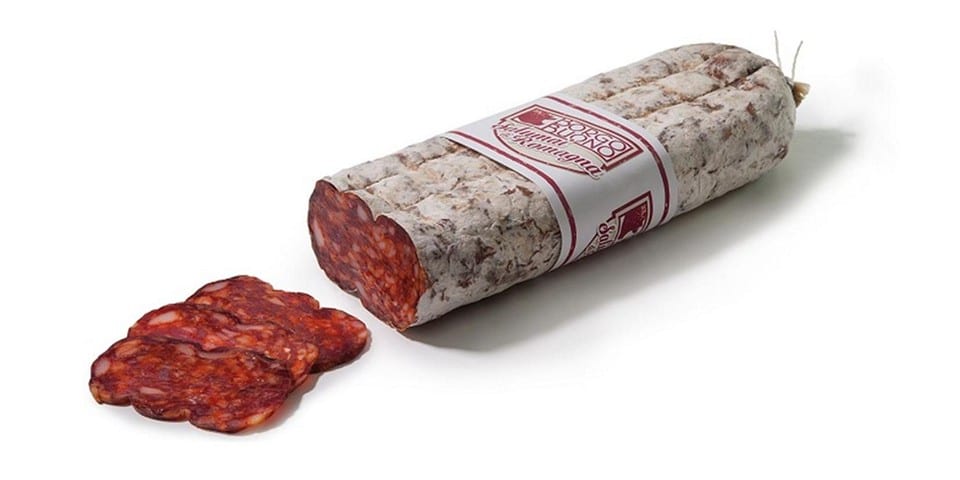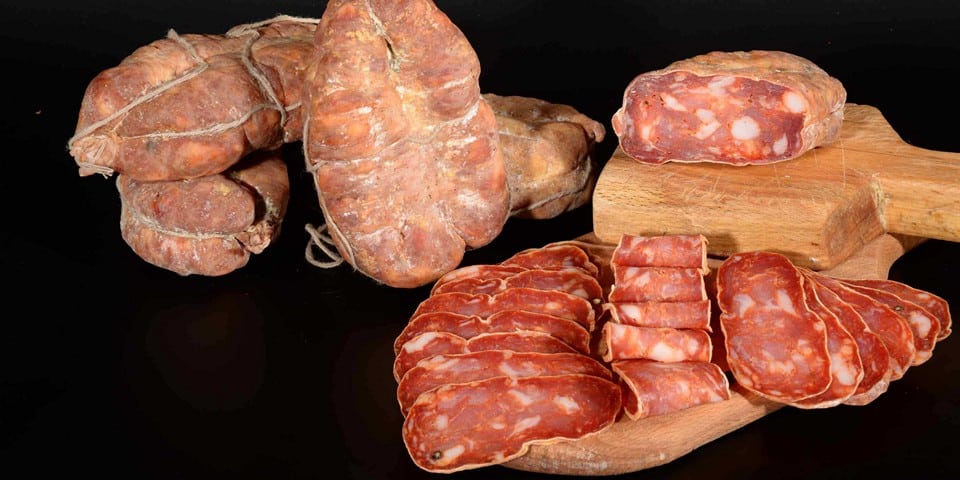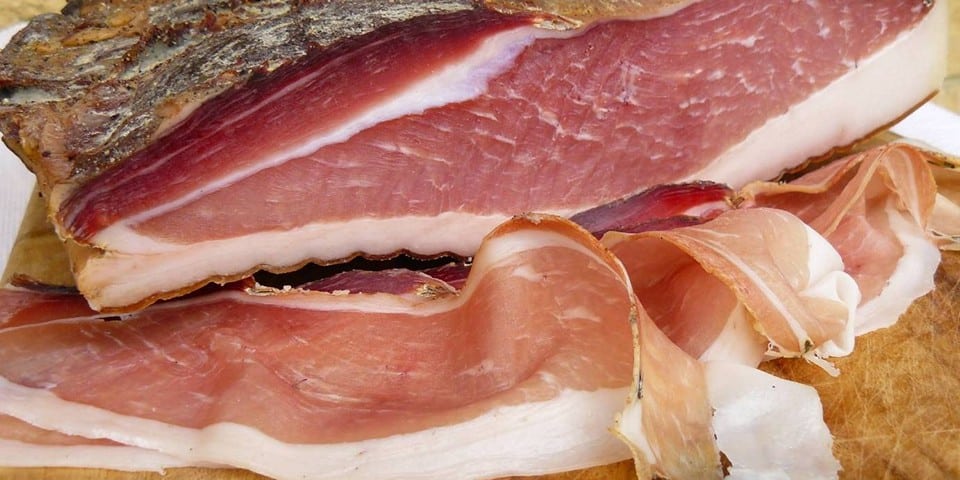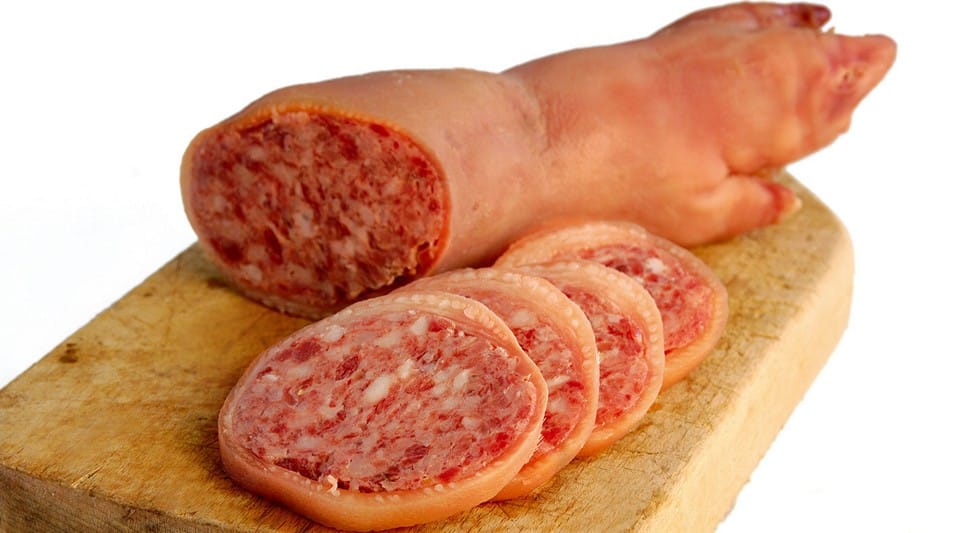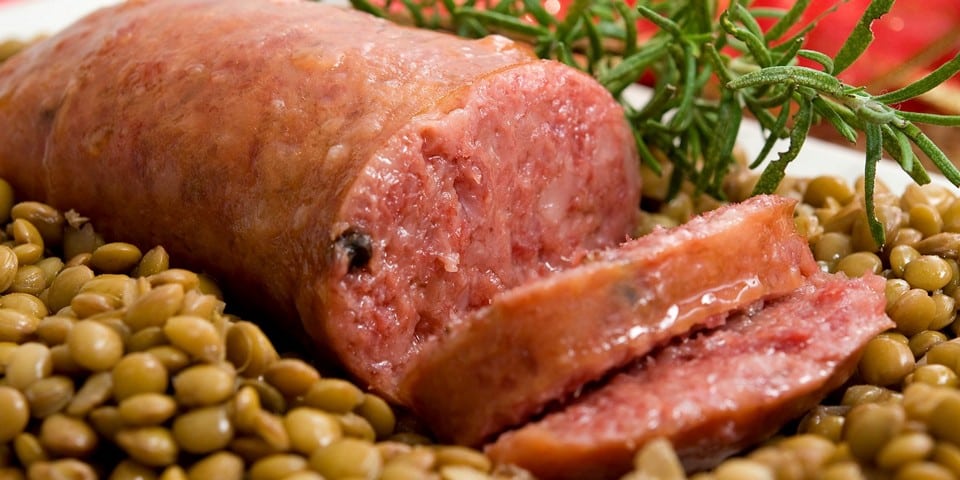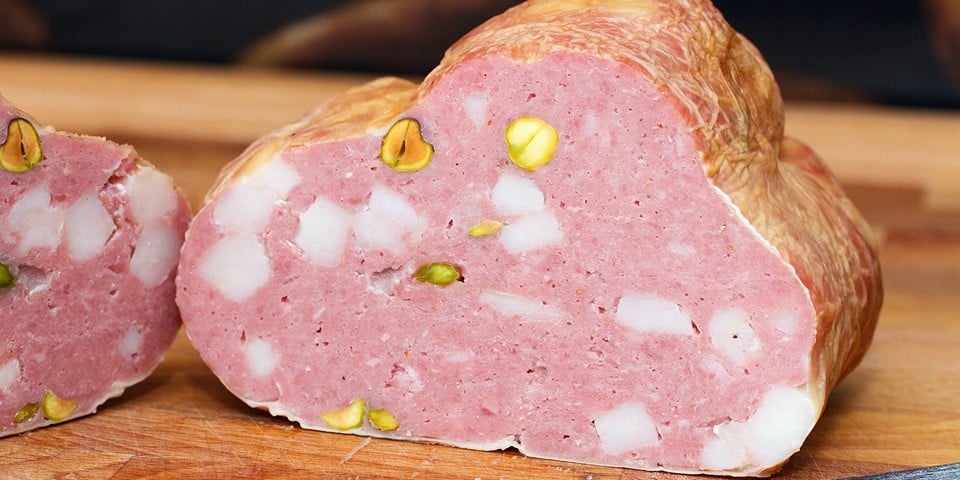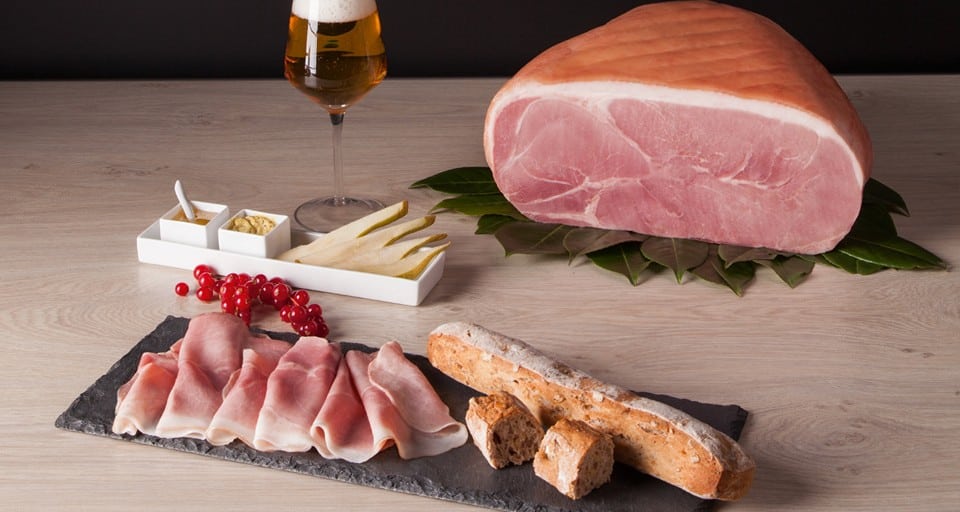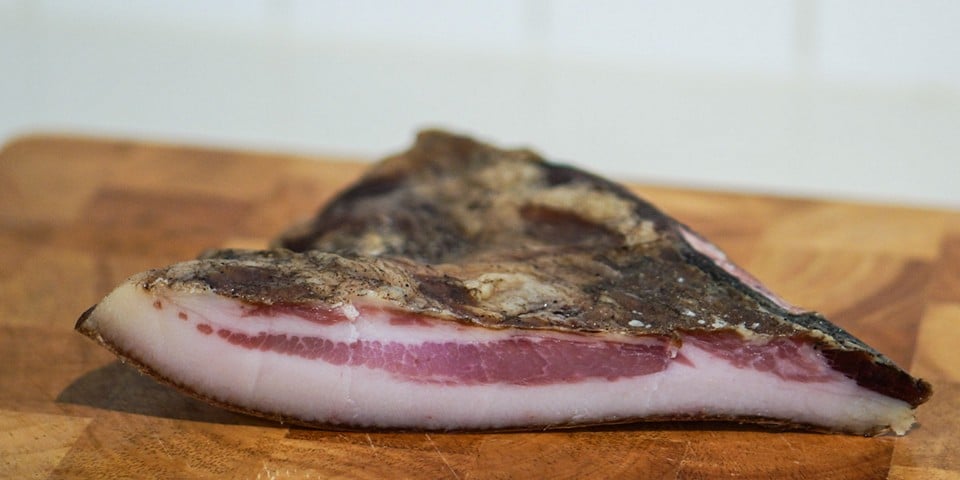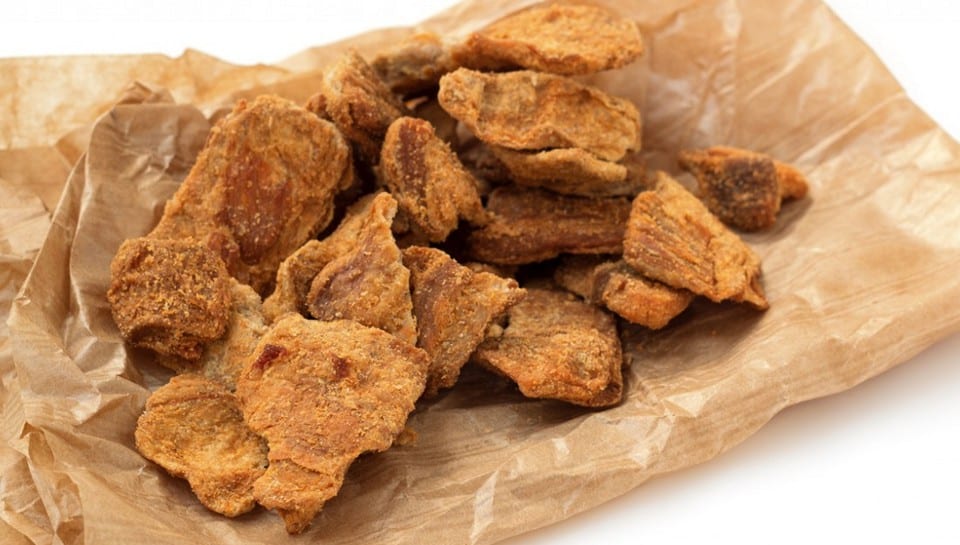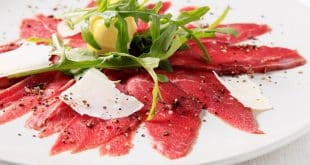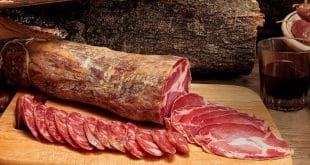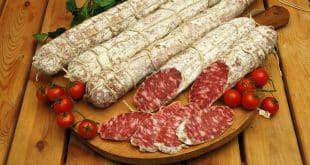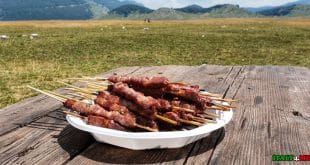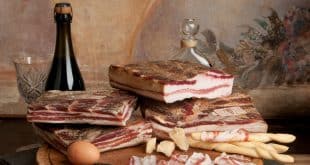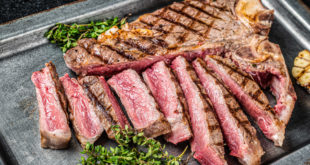Italian Meat – Types and Names
Italy has been a global leader in meat preservation technology since the time of the Roman Empire. Salting, smoking, and drying have endured through the centuries and continue to the present day. Pork is the most common type of meat in the republic. Nevertheless, they also prepare beef, wild boar, and even venison. Spices play a significant role in this art.
Typically, the cured meats from the southern regions of Italy are spicier than those from the northern regions. These products play a prominent role in the world of appetizers and are one of the options for antipasto, which means “before the meal.” This is what they call the first course, consisting of sliced meats, cheese, and vegetables.
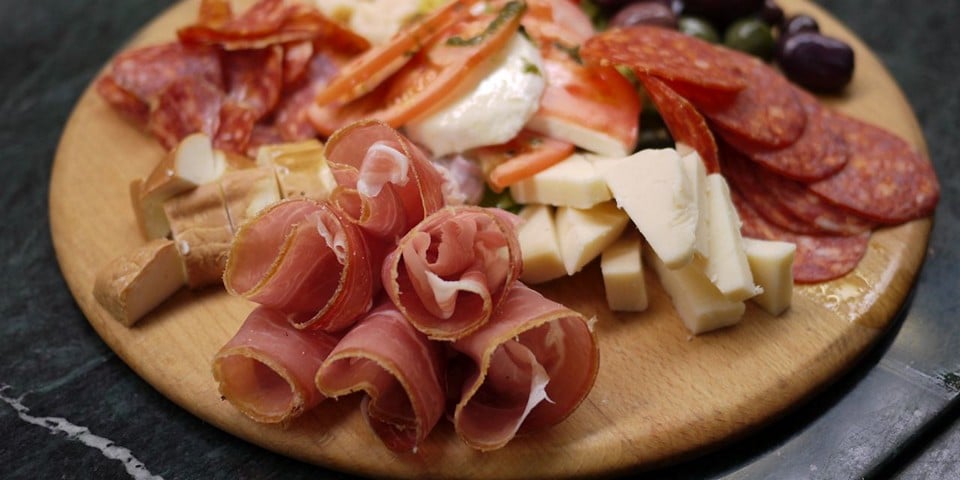
Meat products can be divided into two categories: those made from whole pieces of meat and those made from minced meat in casings (sausage products). In Italy, they classify them differently, based on the method of preparation. They distinguish between:
- Prodotti crudi – products made from raw meat.
- Prodotti cotti – products that undergo heat treatment.
It is based on this principle that we will divide our article, presented for convenience in alphabetical order.
Page Contents
Products from Raw Meat
Prodotti crudi are prepared by a combination of drying and salting. There is no need to worry that they do not undergo heat treatment, as all the raw materials undergo thorough safety analysis. Many products, thanks to their quality, are included in the lists of IGP and DOP categories.
Bresaola
Bresaola is the only Italian meat product made exclusively from beef. Salting the whole piece of meat from the hindquarters with garlic, cinnamon, bay leaf, and cloves takes about 2 weeks. The aging process lasts 1 to 3 months at a temperature of 12-18 degrees.
The finished product is bright red and has a delicate, slightly spicy aroma. The taste ranges from moderately salty to sweet. The texture is soft and compact. This meat is practically devoid of fat and contains a large amount of protein. Bresaola della Valtellina, produced in the province of Sondrio, is designated as IGP. Bresaola is eaten by slicing it into thin pieces and drizzling it with olive oil and lemon juice, accompanied by capers.
Ventricina
Ventricina is a typical sausage from the region between Abruzzo and Molise. There are two main varieties of this sausage: Ventricina teramana and Ventricina del Vastese.
Ventricina del Vastese contains 80% pork meat and 20% fat. This product is separated because the raw materials aren’t minced into a paste-like consistency like most sausages. Instead, they are cut into cubes measuring 2-4 cm.
The prepared meat is rolled in sweet pepper, chili, dill, and salt. Some varieties even include orange zest. The spicy filling is stuffed into the pig’s intestine, stomach, or bladder. Ventricina matures for about 120 days. The slice of the Vasto sausage is red, uneven, and coarse-grained. It has a spicy aroma. It’s typically enjoyed on its own, sliced, and served with bread.
Ventricina teramana, on the other hand, is characterized by higher fat content (60-70%) and includes by-products. The raw materials for it are minced several times in meat grinders. As a result, the slice of the sausage is uniformly pink. This type of Ventricina is eaten by spreading it on bread or used in the preparation of meat sauces.
Coppa
Coppa, also known as capocollo or capicollo, is a product made from the muscle part of the pig’s neck. Its production process is somewhat similar to the preparation of ham and salami.
Its name depends on the region in Italy. Coppa is salted with a blend of pepper and spices (cinnamon, cloves, nutmeg). Afterward, the meat, encased in the pig’s intestine, undergoes 3-6 months of maturation.
The product has a cylindrical shape, tapered at the ends. Its texture is compact and not elastic. The color is red with white specks. It has a sweet aroma, and the taste is delicate, intensifying with aging. Quality-certified varieties include Coppa Piacentina DOP, Capocollo di Calabria DOP, and Coppa di Parma IGP. Coppa is thinly sliced and enjoyed with bread or accompanied by red wine or other light alcoholic beverages.
Culatello
Culatello is one of Italy’s most esteemed traditional meat products, typical of the Parma region. It is made from the meat surrounding the pig’s femur bone. This meat is separated from the skin and excess fat. The bone is manually removed to give the product its characteristic pear shape. It then undergoes a salting process lasting about a week. Afterward, the meat is placed in a natural casing, tied with twine, and sent for aging. The final phase lasts on average 14 months (or no less than 10 months) and occurs at a temperature of 13-17 degrees.
The finished product weighs 3-5 kg. The slice is uniformly red with tiny white strips of fat. It has an intense aroma and a sweet, delicate taste. The DOP quality mark distinguishes Culatello di Zibello. Culatello is served with bread and accompanied by butter. It pairs excellently with dry sparkling wine. To store, the slice of the product is coated with olive oil or butter.
Lardo
Lardo, or simply Italian pork fat, is classified as a meat product in the country. It enjoys great popularity in the northern regions of Italy. To make lardo, they take the fatty part from the back of a pig. In special containers for salting, they layer fat, salt, and spices (such as pepper, cinnamon, cloves, coriander, sage, and more). In this form, the product is left to mature for a period ranging from 3 to 12 months.
The finished lardo appears moist with a white color and a slight pinkish hue. Its texture is uniform and soft. The taste is delicate, almost sweet. Notable varieties include Lardo d’Arnad DOP and Lardo di Colonnata IGP. Lardo is consumed by slicing it thinly and eating it with bread. It is also used in various dishes. In Italian restaurants, you can even find the unusual combination of lardo with seafood.
Pancetta
Pancetta is a traditional Italian product made from the meat of a pig’s belly. Its shape varies depending on the type. For example, pancetta tesa is square-shaped, similar to bacon, while pancetta arrotolata is rolled into a cylinder. It can also come with or without the rind and can be either classic or smoked.
When salting pancetta, even the size of the salt crystals matters—not too fine, but not too coarse—to ensure optimal penetration. Spices used include cloves, nutmeg, pepper, and juniper. The aging process ranges from 50-60 days to 90-120 days, depending on size.
The finished pancetta has a pinkish-white cross-section with broad red streaks. Taste and aroma vary depending on the spices used. Pancetta Piacentina and Pancetta di Calabria have DOP status. Pancetta is diced or sliced and eaten as a cold appetizer, often as part of a mixed meat platter. It is also added to sauces, soups, casseroles, and pizza.
Prosciutto Crudo
Prosciutto Crudo is a typical Italian ham made from the hind leg of a pig. It is prepared using pigs weighing around 150 kg. The main components in making ham are pork, salt, and time. The curing process lasts from 8 to 16 months (some varieties age for 2 years). At one stage, the ham leg is covered with a special mixture to prevent it from drying too quickly.
Prosciutto has the typical shape of a pig’s hind leg. The cross-section is pinkish-red. It has an aromatic smell and a delicate, slightly salty taste. The most well-known types of ham have DOP (Prosciutto di Parma, di San Daniele, di Modena, di Carpegna, Veneto Berico-Euganeo, Toscano, di Cuneo) and IGP (Prosciutto di Norcia, di Sauris, Amatriciano) classifications. Without a doubt, Parmesan ham is the most beloved worldwide.
Prosciutto is eaten on its own, sliced into thin strips. It pairs excellently with fruits, cheeses, and figs, serving as an appetizer for wine and beer. Ham is also added to salads, pizza, and other dishes.
Salsiccia
Salsiccia, or Sausage, is a meat product characteristic of many regions in Italy. The recipe and type of meat used for its preparation vary depending on the region of the country. It can contain pork, turkey, beef, lamb, as well as organ meats (liver, lungs, etc.).
Spices used range from simple ones like salt and pepper to more exotic ones such as garlic, wine, paprika, fennel seeds, and even cheese. The meat is minced, but not too finely, so that the boundaries between fatty and muscular parts are visible. The casing is often natural, but there are also products wrapped in artificial materials.
Some types of salsiccia go through a curing stage (approximately 2 months), like Salsiccia Stagionata, while others are sold raw (Salsiccia Fresca) for home cooking (they are boiled or fried).
In the United States, some varieties of salsiccia are marketed as “Italian sausages.” Its taste is mild and oily and often served with breadsticks and olive oil.
Salami
Salame, or Salami, is a type of sausage originating from Italy, combining minced meat and fat in its composition. Different varieties can differ in size, texture, the spices used, and the aging time. However, there are common processes for all types: grinding the raw materials, mixing with salt and seasonings, stuffing into casings, and aging, which depends on the product’s size and characteristics.
Salami typically has an elongated shape, and the cross-section appears red with white fat specks. The aroma is intense, and the taste varies depending on the variety. Many types of salami have received quality designations like DOP (Salame di Varzi, Brianza, Piacentino, Salamini Italiani alla Cacciatora) and IGP (Salama da sugo, Salame Cremona, d’Oca di Mortara, Sant’Angelo, Felino, Piemonte).
Salame di Milano stands out as one of the most famous and widely sold varieties of Italian salami worldwide, even though it doesn’t have any specific quality designation.
One distinct type of salami worth mentioning is Spianata, which is flattened and has a bright red color. It is often eaten as a snack, accompanied by bread, cheese, and wine, and is used in various recipes.
Soppressata
Soppressata is a special type of sausage recognized as a traditional food product in Italy. It is part of the cultural heritage of the southern regions of the country. Soppressata is typically made from pork, although some varieties use beef. The choice of spices depends on the production region, but it consistently includes salt, black pepper, and often ground paprika. The casing is made from the intestines, which are cleaned with salt and lemon. The sausage is tied with twine and aged for 3 to 12 weeks, depending on its size. During this time, the product loses 30% of its moisture. Some types of soppressata are sold in jars with olive oil.
Soppressata di Calabria is recognized with the DOP designation. It has a cylindrical shape with a compact, slightly soft texture. The cross-section is bright red with white fat specks. It has a sharp aroma and a balanced, spicy taste. Soppressata is often served with pink or white wine and pairs well with bread, cheese, and both fresh and cooked vegetables.
Speck
Speck is a signature Italian delicacy in the South Tyrolean style. It is made from pork leg, with the bone, skin, and some fat removed. The future speck, cut into pieces, should have a balanced ratio of meat and fat. It is then salted for 30 days, combined with spices (garlic, bay leaves, pepper, juniper berries, nutmeg), and undergoes a 10-day smoking process using resinous wood (beech, ash, juniper). The subsequent aging lasts at least 5 months.
Speck has a rectangular, elongated shape. The color of the meat’s cross-section is pinkish-red with a clear boundary between the white fat. It has a spicy, smoky flavor. Speck Alto Adige is recognized with the IGP quality label. From a culinary perspective, it is a versatile product. It is eaten sliced with black bread, accompanied by wine or beer, and pairs excellently with cheese and vegetables.
Prepared Meat Products
Prodotti cotti or prepared products are items that undergo thermal treatment at one of the stages of production or just before consumption.
They are more familiar to the eyes of domestic consumers, as they resemble what we traditionally see on the shelves of our stores.
Zampone
Zampone is a typical Italian sausage made from a mixture of lean pork mince, fat, salt, and spices (pepper, nutmeg, cinnamon, cloves, wine). The sausage casing is stuffed with this mixture, and it takes on the shape and size of a pig’s foreleg. It is sold raw and requires 2 hours of boiling. However, pre-cooked zampone can also be found in Italian food markets.
This product is highly valued because it significantly reduces the preparation time. Zampone Modena, in particular, is recognized with the IGP designation. The color of the sliced zampone is red, and its texture is dense. It is typically consumed in Italy during the winter months, especially during the Christmas holidays. It is often served with white beans, mashed potatoes, or lentils.
Cotechino
Cotechino is a pork sausage originating from Friuli-Venezia Giulia. It is prepared in a similar manner to zampone but using intestines as the casing. It is sold raw in vacuum packaging. Before consumption, cotechino is roasted and boiled. All procedures are done over low heat to prevent the casing from bursting.
Cotechino Modena has received a special IGP designation. The color of the sliced cooked sausage is pink, almost red. Traditionally, it is enjoyed more during the winter months, accompanied by lentils or mashed potatoes. In Italy, it is said that cotechino is a dish for the first day of the year, meaning it is a staple for New Year’s tables.
Mortadella
Mortadella is a typical Italian sausage made from finely ground meat, fat, seasoned with salt, and a small amount of spices. This mixture is stuffed into casings of various sizes, ranging from 500 g to 100 kg. It undergoes thermal treatment in large ovens with dry, hot air for several hours to a full day.
The finished mortadella has a cylindrical shape. The color of the sliced mortadella is uniformly pink with small specks of white fat. It has a spicy aroma and a well-balanced taste. Mortadella Bologna and Mortadella di Prato are recognized as products with the IGP quality mark. Mortadella is served sliced (with bread) or cubed (as an appetizer). It is used in many Italian recipes, including one variant of Bolognese sauce.
Porchetta
Porchetta is a meat product typical of northern and central Italy. It is made from a whole pig weighing between 27 to 45 kg. The pork carcass undergoes manual dressing, where hair, some bones, and innards are removed, leaving the head intact. The meat is salted and seasoned with spices (black pepper, garlic). In the central part of the country, rosemary is added for flavor, while in the northern regions, fennel is used. The prepared meat is used to stuff the pig, which is then sewn up and tied with string. The future porchetta is roasted on a spit in an oven for 2 to 5 hours, depending on its size.
The finished product has a crispy brown crust and a sharp taste. The meat is white-pink, and the taste depends on the spices used. Porchetta di Ariccia received the IGP designation in 2011. Porchetta is typically consumed fresh (distinguished by its crispy crust) with rolls or flatbreads.
Prosciutto Cotto
Prosciutto Cotto, or cooked ham, is an Italian deli meat. It’s made without bones, similar to sausage, but whole meat is used. For the finest varieties, they use pork thigh meat. After deboning, salt and spices are added using special machines. Then, it undergoes a cooking process at 75 degrees Fahrenheit, lasting for 9-12 hours. Prosciutto Cotto has several categories:
- Prosciutto Cotto.
- Prosciutto Cotto Scelto.
- Prsciutto Cotto Alta Qualita.
The last one guarantees high-quality raw materials and strict production control.
The color of the sliced cooked ham is light pink with a thin layer of fat. It has a delicate flavor. It’s enjoyed on its own as an appetizer with wine. It’s also used to make toast with white bread and incorporated into various recipes like pizzas, omelets, pies, and chicken cordon bleu.
Sausages
Sausages, known as Wurstel in Italian, are a meat product originating from Central Europe and have found a firm place on Italian tables. They are prepared from a mixture of meat, pork fat, salt, and spices. Italians have high standards for the quality of meat used in wurstel, and they can be encased in natural (intestines) or artificial casings. There are also skinless versions available. The casing is removed before being packaged in jars with a jelly-like brine.
Wurstel are typically small and intended for single servings. They have a pink color, and the taste varies depending on the spices used, such as onions, pepper, oregano, and more. Before consumption, they are either boiled or grilled. They are served with sides like french fries or salads.
Unusual Meat Products
Some meat products from Italy deserve a separate mention because, although traditional for Italians, they can be a delightful discovery for visitors to the country.
Violino di Capra
Violino di Capra, which literally means “goat violin,” is a meat product made from the shoulder or thigh of a goat. Its name comes from its shape, which resembles a violin. Traditionally, for slicing Violino, it’s rested against the shoulder, and a knife is used like a bow. To prepare it, fresh meat with bones is salted and seasoned with spices such as cloves, bay leaves, coriander, juniper berries, pepper, garlic, cinnamon, rosemary, and thyme. The product matures for 3-6 months, and in rare cases, up to a year.
The shape of violino is elongated, and triangular. The weight ranges from 3.3 to 4.4 lbs (1.5 to 2 kg). The color of the cut is dark, close to burgundy. The product has a unique flavor. Its production is quite rare. Violino is traditionally consumed individually, slicing the “violin” at the table until it’s finished.
Guanciale
Guanciale is a cured meat made from pork jowls (guanciale di maiale). They are rubbed with salt, sugar, and spices (black and red pepper, thyme, fennel, garlic). Guanciale matures for about 3 weeks, during which it loses approximately 30% of its weight. In some regions, Guanciale has the status of a traditional food product.
Its aroma is stronger than that of other pork products, and its texture is more delicate. The product is eaten in small quantities. However, it is more commonly used to prepare pasta sauces, such as amatriciana.
Wild Boar Salami
Wild Boar Salami (Salame di cinghiale) is a sausage made from carefully selected and trimmed meat from wild boars, with the addition of pork fat. The fat gives the product a softer texture and extends its shelf life. The meat is ground finely, and salt, pepper, and garlic are added. The product matures in natural casings for no less than 5 weeks.
Wild Boar Salami has a unique, distinctive taste, and a bold aroma. This sausage is often served as an appetizer before game dinners and pairs well with red wine.
Stigghiola
Stigghiola is a Sicilian product typical of Palermo. It’s a rather exotic dish, the main component of which is lamb, goat, or chicken intestines. They are washed in salty water, stuffed with parsley, onions, and other herbs, then wrapped in leek and grilled like skewers.
Usually, this delicacy is prepared and sold as street food. In Ragusa, the dish is baked in small pots and called “turciniuna.” The Ministry of Agriculture and Food has included Stigghiola in the list of traditional Italian food products.
Ciccioli
Ciccioli is surprisingly an Italian footwear brand and a traditional meat product similar to Ukrainian cracklings. Fat is cut into small pieces to prepare them and slowly heated to melt the fat and evaporate moisture. When Ciccioli turns a yellowish color, excess fat is removed, and spices like cloves, cinnamon, pepper, and nutmeg are added. Sometimes they are salted. Cracklings are widespread throughout Italy, but each region has its own name for them. For example, in Piedmont, they are called “grasëtte,” in Marche – “sgrisci,” and in Campania – “lardinzi.”
There are soft and crispy Ciccioli. The former is perfect for hot cereals, while the latter makes a great appetizer or filling for rustic pies. There’s also a pizza variation with cracklings – “pizza pe ret frittole.” In Naples, they are eaten with ricotta and pepper.
It’s hard to imagine, but there was a time when poor Italians had to sail to America to escape hunger and get a meal. Times have changed. Now, many of us should visit Italy to enjoy the taste of authentic meat delicacies fully.
 Italy for me From Italy with love
Italy for me From Italy with love


